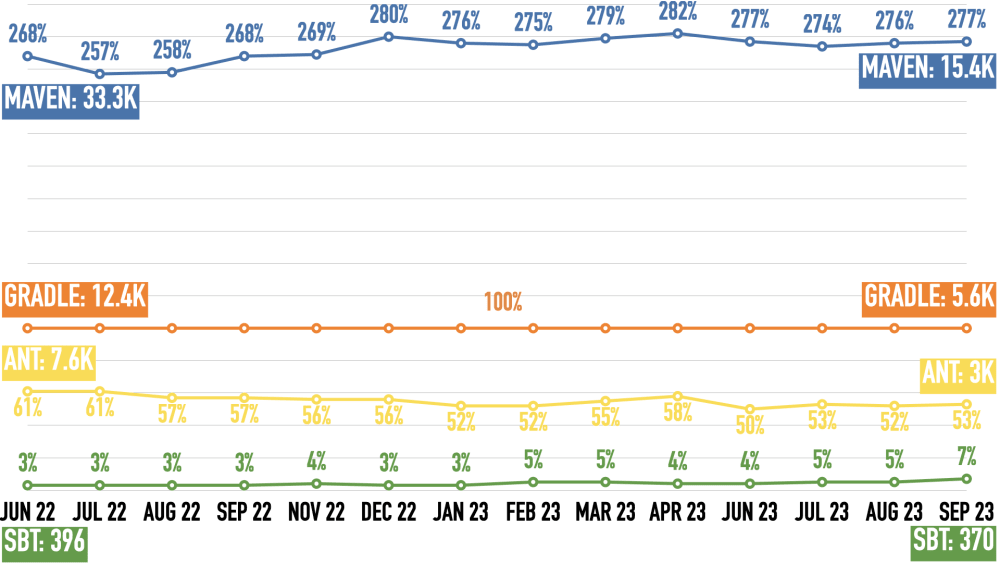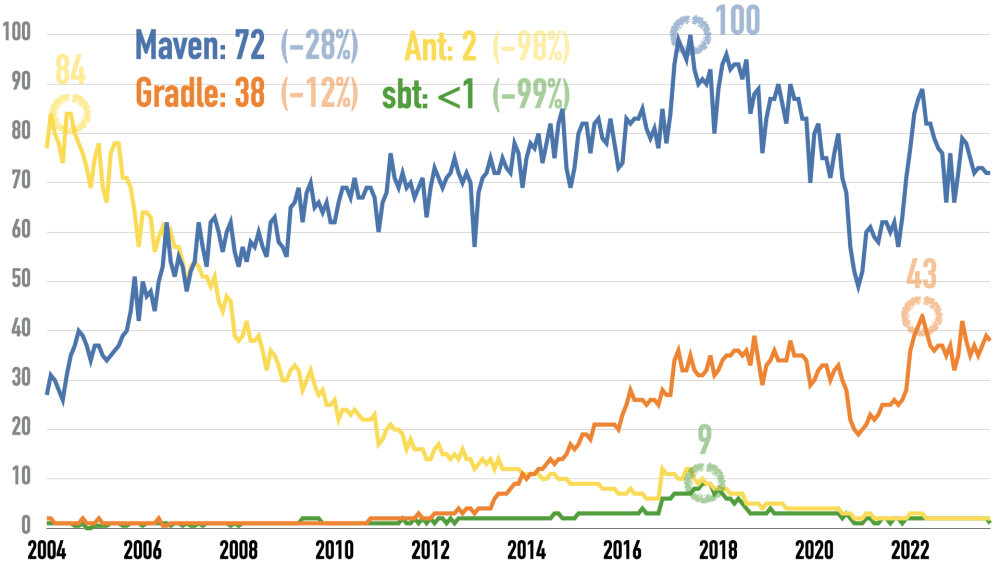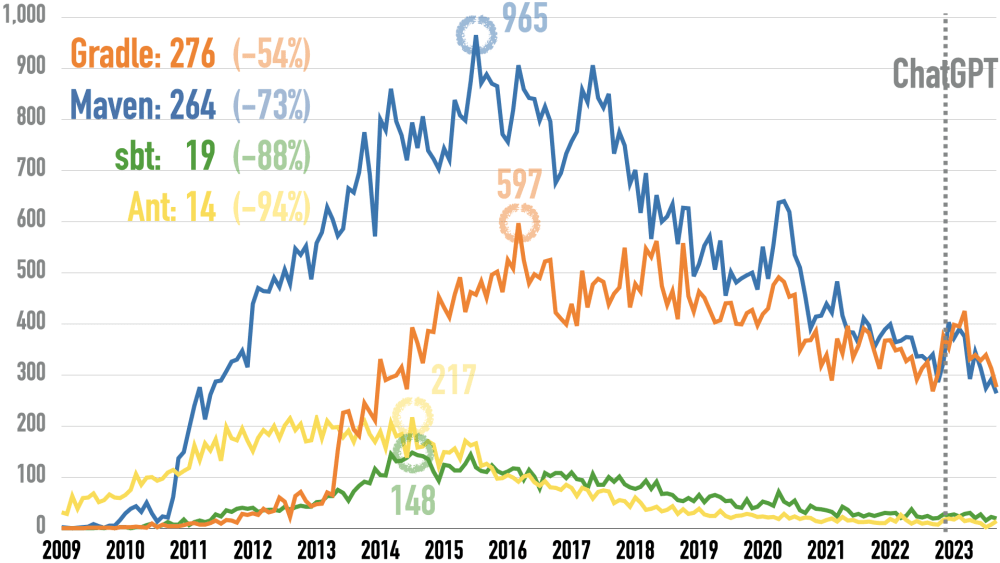Java Tech Popularity Index Q4/2023: Build Tools
Summary for Q4/2023
Here is the scorecard of Maven (left) and Ant (right) vs. Gradle (100%), not on the card. The arrows show the trend vs. Gradle.

Maven loses to Gradle except for jobs, where it rises slightly. Ant has disappeared from searches and Stack Overflow and trends downwards in jobs.
Here are my recommendations:
- If you use Scala, then use sbt.
- Otherwise, if you absolutely cannot stand XML files and/or need to customize your build heavily, then use Gradle.
- Otherwise, use Maven.
Archive
| 2023 | Q3 | Q2 | Q1 |
| 2022 | Q4 | Q3 |
Table Of Contents
Choices
Here are the choices in alphabetical order:
Popularity
Why Popularity - and How?
Picking a popular technology makes our developer life easier: Easier to learn, easier to build, debug & deploy, easier to find jobs/hire, and easier to convince teammates & bosses. Popularity can make a difference in two situations: When multiple technologies score similarly, we could go for the most popular one. And when a technology is very unpopular, we may not use it.
I measure popularity among employers and developers as the trend between competing technologies. I count mentions in job ads at Indeed for employer popularity. For developer popularity, I use Google searches, Udemy course buyers, and Stack Overflow questions.
Employers: Job Ads
The Indeed job search is active in 62 countries. I picked 59 countries representing 69% of the worldwide GDP in 2022, excluding three countries because English word searches proved ineffective there: China, Japan, and South Korea. Job searches demonstrate the willingness of organizations to pay for a technology - the strongest indicator of popularity in my mind. Gradle is the baseline.

There are no job ad numbers for May 2023 because of changes on the Indeed websites.
Maven wins, Gradle is second, Ant is third, and sbt is last. The number of developer ads is down in 2023: Maven and Gradle lost about 55% of their ads. Maven leads Gradle 2.8:1, being back to where it stood last January. Ant hold steady this year while sbt jumped up – because everybody else fell..
Please see here for details, caveats, and adjustments to the job ad mentions.
You can find the detailed search results with links here. They include breakdowns by continents:
Developers
Students at Udemy
Udemy is one of the biggest online learning sites. They publish the number of people who bought a course (beyond a certain threshold, possibly around 100k). This shows how many people evaluate a technology.
Unfortunately, Udemy shows the number of students only for Maven (149k). That’s why there’s no chart here, as a comparison is impossible.
Here are the links that show the courses for all and the number of students for some:
Google Searches
Google Trends demonstrates the initial interest in a technology over time. “More searches = better” to me. The percentage behind the current value is the drop-off from the peak value, marked with a circle. This is the chart link.

Google changed its measurement algorithms on January 1, 2016, and January 1, 2022. That caused spikes for all values, especially in 2022.
Maven wins, Gradle is second, Ant is third, and sbt is last. Maven leads Gradle 2.3:1. Maven and Gradle have roughly moved in lockstep since 2020. While Maven’s 28% off its peak value, Gradle has only lost 12%. Ant has declined by 98% in the last 19 years and is on its way out. sbt has always had a very low search volume and has had losses for six years.
Monthly Questions at Stack Overflow
We can run database queries against the questions, answers, and comments at Stack Overflow with the StackExchange Data Explorer. The number of monthly questions is a proxy for using a technology during evaluation and productive use. “More questions = better” to me. The percentage behind the current value is the drop-off from the peak value, marked with a circle.

Gradle wins, Maven is second, sbt is third, and Ant is last. Maven and Gradle have traded the #1 spot a couple of times over the last months. Maven has declined more than Gradle. Ant and sbt peaked nine years ago and slide towards zero.
Please note that the overall monthly number of Stack Overflow questions is down 42% since ChatGPT appeared (November 2022 vs. October 2023):

I used two queries to get the number of monthly questions below because putting all in one query timed out. You can run them in the StackExchange Data Explorer.
(Click to expand) Query 1: Ant and Gradle
DECLARE @StartDate DATE = '2009-01-01';
DECLARE @EndDate DATE = '2023-09-30';
WITH Tagged AS (
SELECT
Id,
CreationDate,
CASE WHEN CHARINDEX('<gradle>', Tags) > 0 THEN 1 ELSE 0 END AS GradleTag,
CASE WHEN CHARINDEX('<ant>', Tags) > 0 THEN 1 ELSE 0 END AS AntTag
FROM Posts
WHERE
PostTypeId = 1 AND -- 1 for
CreationDate >= @StartDate AND
CreationDate <= @EndDate
),
MonthlyCounts AS (
SELECT
DATEADD(month, DATEDIFF(month, 0, CreationDate), 0) AS Month,
SUM(GradleTag) AS Gradle,
SUM(AntTag) AS Ant
FROM Tagged
GROUP BY DATEADD(month, DATEDIFF(month, 0, CreationDate), 0)
)
SELECT
Month,
Gradle,
Ant
FROM MonthlyCounts
ORDER BY Month;
(Click to expand) Query 2: Maven and sbt
DECLARE @StartDate DATE = '2009-01-01';
DECLARE @EndDate DATE = '2023-09-30';
WITH Tagged AS (
SELECT
Id,
CreationDate,
CASE WHEN CHARINDEX('<maven>', Tags) > 0 THEN 1 ELSE 0 END AS MavenTag,
CASE WHEN CHARINDEX('<sbt>', Tags) > 0 THEN 1 ELSE 0 END AS sbtTag
FROM Posts
WHERE
PostTypeId = 1 AND -- 1 for
CreationDate >= @StartDate AND
CreationDate <= @EndDate
),
MonthlyCounts AS (
SELECT
DATEADD(month, DATEDIFF(month, 0, CreationDate), 0) AS Month,
SUM(MavenTag) AS Maven,
SUM(sbtTag) AS sbt
FROM Tagged
GROUP BY DATEADD(month, DATEDIFF(month, 0, CreationDate), 0)
)
SELECT
Month,
Maven,
sbt
FROM MonthlyCounts
ORDER BY Month;
(Click to expand) Query 3: All Questions
DECLARE @StartDate DATE = '2009-01-01';
DECLARE @EndDate DATE = '2023-10-31';
WITH Questions AS (
SELECT
Id,
CreationDate,
1 AS AQuestion
FROM Posts
WHERE
PostTypeId = 1 AND -- 1 for questions
CreationDate >= @StartDate AND
CreationDate <= @EndDate
),
MonthlyCounts AS (
SELECT
DATEADD(month, DATEDIFF(month, 0, CreationDate), 0) AS Month,
SUM(AQuestion) AS Questions
FROM Questions
GROUP BY DATEADD(month, DATEDIFF(month, 0, CreationDate), 0)
)
SELECT
Month,
Questions
FROM MonthlyCounts
ORDER BY Month;
Analysis
- Maven dominates Java build tools with 2.5 times the values of Gradle, except for Stack Overflow. It’s the default build system in the Java world. Unlike Gradle, few things break from release to release. Developers like that stability! Its verbose XML files are a minus for some. And creating custom build tasks is more complicated than in Gradle: You write a Java class and distribute the task alongside your build file.
- Gradle is the runner-up in Java build tools. It’s faster than Maven and has much smaller build files, which can be either in Groovy or Kotlin. Creating custom build tasks is easy: We just add a method in the build file. Unfortunately, more things break from release to release than in Maven. That can be annoying!
- Ant is the granddaddy of Java build tools: Its first release was in July 2000. Unlike other granddaddies, it’s still active: Its job ad mentions are 55% of Gradle’s. There are probably a ton of legacy projects using Ant. But we shouldn’t use it on new projects – Maven and Gradle are much better options.
- sbt is the odd man out here: It’s mainly used for Scala projects. The build files are also written in Scala.
So here’s my recommendation:
- If you use Scala, then use sbt.
- Otherwise, if you absolutely cannot stand XML files and/or need to customize your build heavily, then use Gradle.
- Otherwise, use Maven.
Next Issue
The next issue will arrive in November 2023. Subscribe to it as a newsletter to have it in your inbox then!